When Cobb & Co
ran coaches....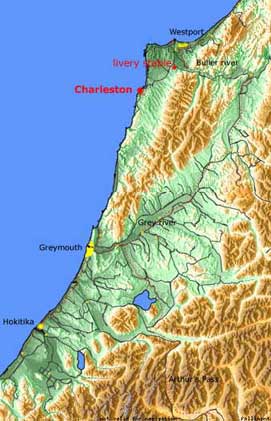
Cobb & Company
was first formed in Melbourne, Australia, in 1854 by Freeman Cobb, John
Peck and others. Peck had been employed in the USA by the Wells Fargo Stagecoach
Company. He used his knowledge and expertise to give Cobb & Co. a reputation
of being fast, reliable and punctual, throughout Australia.
This Australian
firm did not set up as a coach company in New Zealand during those early
years. However, their trade name was used extensively by private coach owners
throughout this country to take advantage of the Cobb & Co. public image
of reliability and punctuality. FULL
DETAILS
A major coach
road was the one over the Southern Alps via Arthurs Pass to Christchurch.
The Arthurs Pass coach ran for 57 years from 1866 until the Otira rail tunnel
opened in 1923. The 250 km journey over the Main Divide from Greymouth to
Christchurch was so rough it took 3 days to complete and involved 11 staging
stops.
From the Buller to
the Grey....
This is a great
song, and Punakaiki historian Les Wright says he loves it, but nevertheless
he notes that the coach road did not go through Charleston at the time of
the goldrush. There were too many coastal cliffs and pakahi swamps, although
he says a telegraph link from the Buller to the Grey, via Charleston, was
completed in 1868.
The
coach road from Westport to Greymouth bypassed Charleston, going inland
via the Buller gorge to Reefton, then down the Grey river valley. It was
not until 1929 that you could travel by road from the Buller to the Grey
via Charleston.
However,
as the saying goes, "Never let the truth get in the way of a good story!"
See Mr Wright's
full story of the Charleston road HERE.
And she's dancing
in the bar....
Actually,
girls were forbidden by law to dance in hotel bars. Punakaiki historian
Les Wright says:
"Dancing
girls were employed to dance with men and encourage them to buy drinks.
Because of this, dancehalls weren't permitted in hotels - but they were
often situated next door.
"There
were also prostitutes, and dancehall girls may have moonlighted in that
trade too. The dancing girls were not stage performers; the can-can didn't
arrive until the 1890s so far as I know.
In a pit of yellow
clay....
With dirty
drinking water, poor sanitation, a cold damp climate and not much fresh
food, Cape's red-haired girl was probably struck down by Tb, dysentery or
typhoid -
Les Wright says that the early dancing girls would have been buried in Charleston's
cemetery down by the sea shore in Constant Bay.
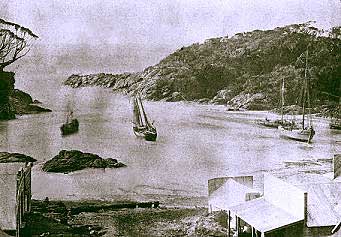
Constant
Bay, Charleston
|
But this cemetery was difficult to reach at high tide, and then it became
threatened by mine tailings, so they opened two other cemeteries.
When we passed
through Charleston in 1987, we visited these two cemeteries, a Protestant
one on the hill to the north, and
the Catholic one by the "winding Westland highway," so Peter Cape's
fictitious red-haired girl was obviously an Irish Catholic.
The totara
wood grave-markers of the poorer people had all been burnt up when the abandoned
gorse-covered cemeteries were swept by fire. But we did find a granite slab
marking the grave of a 23 year old school-teacher, much-loved by her pupils.
However we
could not find the derelict two-story, false front, corrugated-iron European
Hotel I had seen on a previous visit in 1967. The remains of the hotel were
pulled down and burnt following the 1967 centennial
celebrations, held not long after I visited there.
Bill Fox the
Prospector
The Fox River
30 miles south of Charleston is named after Bill Fox who was born in Ireland
in about 1826. A sailor, he was on the Californian goldfields about 1850;
then on the Victorian goldfields in Australia; and on the Tuapeka goldfield
in Otago in 1861.
In 1862 Bill
Fox's prospecting activities in the Arrow district excited intense interest
and determined pursuit, but his claim to have made the original Shotover
River discoveries was not accepted. A burly man, Fox was given to brawling.
A serious fight in 1864 led to of six months' hard labour in Dunedin gaol.
Released
in November 1864, Fox travelled to the West Coast. He prospected widely
for gold, and first discovered it at Fox Creek, a tributary of the Arahura
River, behind Hokitika, in January 1865.
In July 1866
Fox organised a prospecting voyage to what was later named Fox River, but
didn't find gold there. He led the party on north to where Charleston would
later be, but although they found gold there, it was too fine to save. So
Fox went south to Okarito to find out how they were doing it there.
DNZB
biography
It's in Charleston
far away....
In August 1866,
while Fox was away, Timothy Linehan took the credit for the Pakihi ('Parkeese')
field which later became known as the Charleston field. At first, goods
going to 'Parkeese' were landed at Woodpecker Bay, south of Fox River, and
humped about 20km north to the goldfield.
|
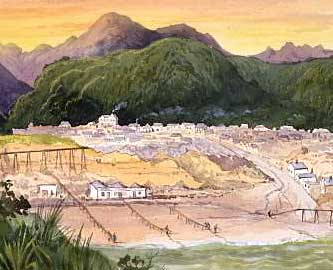
Charleston
1885, detail of a watercolour by Willam Fox
|
Then Capt Charles
Bonner managed to squeeze the ketch 'Constant' into a tiny bay, and the town
that formed around this new landing spot,Constant Bay, was named Charleston,
probably in his honour.
In November
1866 Fox made a rich strike at Brighton (now Tiromoana), about 10 miles
south of Charleston, and in May 1867 a strike near Charleston itself precipitated
the last real 'rush' on the West Coast.
Brighton
was a much bigger town at the start, but Charleston lasted longer
and the two have been confused in places. In 1867 Brighton and its
environs had 53 hotels while Charleston had 37.
The population
of Charleston is often exaggerated, says Les Wright, with 30,000 or even
100,000 being mentioned. At the peak of the gold rush, the population of
the entire West Coast is believed to have been only 35,000.The early 1867
census, at the peak of the Charleston rush, showed 5000 on the entire Charleston
field and 6000 on the Brighton field ten miles to the south.
Prospector
William Fox died in 1893 and his grave is in the Reefton cemetery. (NZ Premier
William Fox also died in 1893 and lies buried in Auckland.) There is a gravestone
for a man named William Fox in the Protestant cemetery at Charleston, but
he was a farmer who died in the early 1900s.
 There's
a schooner down from Murchison.... There's
a schooner down from Murchison....
This
was the American prairie schooner, a lightweight wagon covered by
a white sailcloth.
I can hear it in the gorge....
|

|
The road
came from Nelson to Murchison, and then down through the Buller Gorge.
At the
mouth of the gorge, says Les Wright, a ferry took coaches etc across
the river, and the road then continued on to Westport.
If
the stable lad could hear it coming down the road through the gorge,
the livery stable must have been on the coach road at the gorge's lower
end.
At the
ferry crossing was the Nine Mile Hotel which had a livery stable.
(J Halkett Millar 'High Noon for Coaches' 1965). This is where
our livery stable lad must have worked.
A
Cobb & Co coach crossing the Buller river.
|
Drive a four-in-hand
to Charleston....
Here is Les
Wright's history of the Charleston road.
"The
route from Westport to Charleston was first via ferry across the Buller,
then mainly via the beaches with bits of track over headlands as required.
(I. Faris, 'Charleston', 1940)
The rest of the way to the Grey was by inland pack tracks and beaches.
Then in the early 1900s the road was pushed north and south in stages.
Jack
Powell (b. Charleston, 1901) told me how he went with his grandfather
packing goods to Fox River c1905. At that stage the road went from Charleston
to somewhere south of Four Mile and just stopped, with a rough track through
the bush to pick up the pack track.
Bill
Fischer (b. Westport c. 1904) told me that when he was about 12, living
at Punakaiki, he would take a horse along the track and beach each weekend
to collect goods from a shed at the road end which by that stage had reached
the top of White Horse Hill.
Jack
Powell also recalled the road having got that far when he and his brother
took a plough to Punakaiki about World War One. They got the plough down
the pack track to the beach and then took turns riding the horse and steering
the plough.
Bill
Fischer later worked on the road when it advanced toward Punakaiki, and
also worked on the Fox River bridge which was completed after the road
was opened, cars going through a tunnel on the south side to reach a ford
upstream. The road from the south reached Punakaiki River c. 1922.
James Bourke
drove a Model T Ford right through from Westport to Greymouth (with the
aid of wooden planks and steel nerves) on Good Friday 1928. But
the road was not offically opened to traffic until early in 1929."
Thanks
Our thanks
to Les Wright
of Green Kiwi
Tours, Punakaiki, for generously imparting all this accurate information
acout Charleston.
Watch
out for his forthcoming book about the Brighton gold rush.
The Stable Lad on Record
- 1975 Phil
Garland, Colonial Yesterdays, LP/cass
- 1982 Graham
Wilson, "Billy on the Boil," LP
- 1996 Mike
Harding, "From The Tracks," cassette
- 1997 Shona
Laing, "Roadworks." CD, as The Buller To The Grey
- 1998 Mike
Harding, "Past to the Present," CD
- 1999 Gordon
Bok, "In the Kind Land," Timberhead CD, (Maine USA)
- ---? Stuart
Bougen "Stuart and Heather" cassette
- 2000 Shiner
"Kiss The Kilkenny" Independant, CD
- 2001 Phil
Garland, Swag
O'Dreams CD
- 2002 Phil
Garland, on the Peter Cape compilation CD "An Ordinary Joker"
2006 Mallory Gawn "Malcontents Malarky" Powertool CD
Song
List - Copyright - Home
Photos and
historical details added to web page in May-June 2005
 There's neatsfoot on my fingers,
and lamp-black on my face,
And I've saddle-soaped the harness
and hung each piece in place,
But my heart's not in the stable,
it's in Charleston far away,
Where Cobb & Co goes rolling by
from the Buller to the Grey.
There's neatsfoot on my fingers,
and lamp-black on my face,
And I've saddle-soaped the harness
and hung each piece in place,
But my heart's not in the stable,
it's in Charleston far away,
Where Cobb & Co goes rolling by
from the Buller to the Grey.
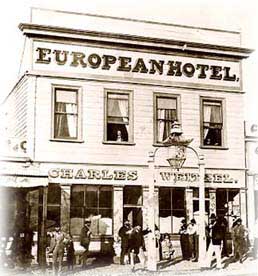
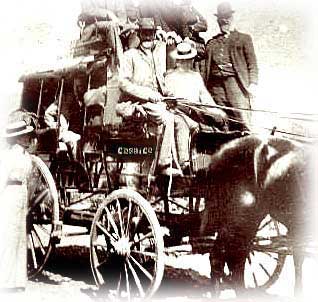



 There's
a schooner down from Murchison....
There's
a schooner down from Murchison.... 